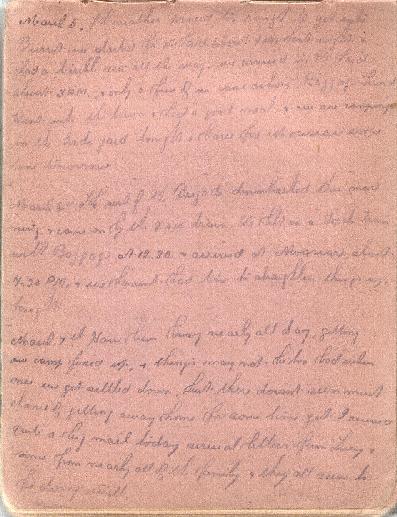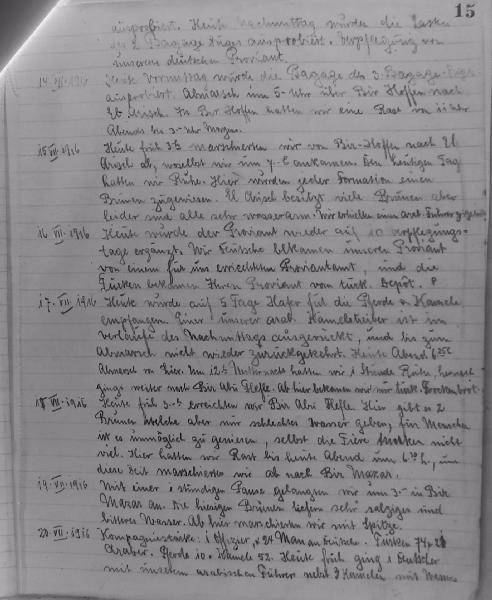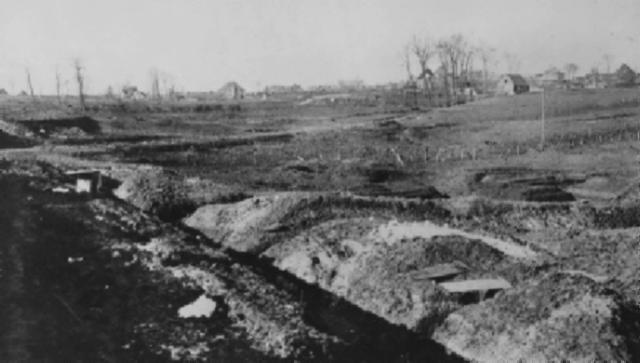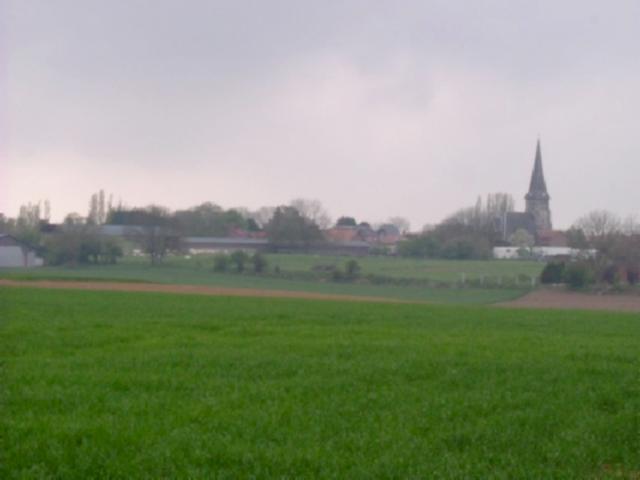Topic: BatzS - Suez 1915
Suez Canal Attack
Egypt, January 28 - February 3, 1915
Official British History Account, Pt 6b
The following is an extract from:
MacMunn, G., and Falls, C., Military Operations Egypt & Palestine - From the Outbreak of War with Germany to June 1917, London, 1928, pp. 34 - 36.
Chapter II
NOTE III.
THE EXPEDITION AGAINST THE CANAL, FROM GERMAN AND TURKISH SOURCES.
The chief authority as to the happenings on the Turkish side is a German officer, Oberst Freiherr Kress von Kressenstein, who also appears to have been the soul of the expedition against the Canal and responsible for the details of its undoubtedly excellent organization. This officer has written an account which is interesting without being of high value in the early stages from the historian's point of view, as he there seldom mentions the numbers of formations and appears to have written rather from memory than from a diary, still less from official archives.
From his story, it appears that from the very date of mobilization on the 2nd August 1914, months before Turkey entered the war, the commander of the Turkish Fourth Army at Damascus, General Zekki Pasha, was instructed to make plans for an attack on the Canal. The conquest of Egypt was not then contemplated. That idea came only with the appointment of the Minister of Marine, Djemal Pasha, as Commander-in-Chief in Syria and Palestine. It may even then have been due merely to the desire of the new general to arouse by propaganda enthusiasm for the liberation of Mohammedans from unbelievers, and to urge on the troops against what was certainly an admirable country to pillage.
It was soon discovered that neither Zekki Pasha nor his Chief of the Staff was qualified for the task. Enver then put it in the hands of the commander of the VIII Corps at Damascus - Colonel Djemal Bey (known as Djemal Kuchuh, the "little Djemal") - and sent him a German staff of six, with Kress as its chief. In November, about the date of the declaration of war, Zekki was succeeded by the energetic and vigorous Djemal Pasha, who brought as his Chief of the Staff Oberst von Frankenberg und Proschlitz. The preparations now went forward much more speedily. Camels were purchased, roads made, supplies of all kinds collected, as was duly reported in Egypt. In mid January the expedition, consisting, according to Kress, of 20,000 men, with 9 batteries of field artillery and one 15-cm. howitzer battery, moved out from Beersheba in two echelons.
Kress had made a very careful reconnaissance of the Desert of Sinai, and his appreciation is interesting. He was evidently a bold and resolute man, who was not daunted by conditions that appeared at first sight most unfavourable, but were in the end overcome with comparative ease by good organization. The main difficulty for an expedition crossing the desert was, as he recognized, the water supply. Whilst a part of the hinterland of the desert was covered with chimes almost impassable to large bodies of troops, the rest had, as has been stated, a better surface, covered with what Kress describes as a "ready-made macadam." This, however, was broken by islands of deep, shifting sand, up to several square miles inn extent, across which the Turks with extraordinary patience constructed brushwood tracks.
The few thousand nomad Bedouin who, as Kress puts it, eke out a scanty livelihood by robbery and cattle raising, he found unreliable as soldiers or traders, but states that they gave invaluable service as guides, and so long as the Turks and Germans were masters of the desert served them, with rare exceptions, faithfully. This, he considered, was due to their hostility to the British, rather than their friendship for the Turks. The former, he declares, had done nothing to improve the material existence of the Bedouin, their policy being to maintain the desert as a barrier between Palestine and the Canal. Except at a few of their evacuated stations, he and his expedition, he somewhat naively complains, came upon no wells sunk by British.
Disregarding all the precedents, as he declares with pride, of the invaders of history, the force marched through the desert instead of following the coast. The old road along which marched so many great armies, through El Arish, was threatened by hostile ships. That from Ma'an, through Nekhl, to Suez, was also under the guns of British warships in the neighbourhood of Aqaba. The water supply was under the control of the German Major Fischer, who had 5,000 camels carrying water. Thanks to his organization, and to the fact that the season had been wetter than usual, there was never any water shortage. The invaders found springs at Kossaima, 45 miles south of El Arish, and, at Hubr um Mukhsheib, 20 miles east of Deversoir, a pool of rainwater that sufficed them during the halt in front of the Canal. On the march not a man or a beast was lost.
The main body marched from Beersheba, through El Auja and Ibni, between the hill-ranges of Maghara and Yelleg, through Jifjafa upon Ismailia. Smaller detachments moved by El Arish upon Qantara and through Nekhl against Suez. The object of these two latter was merely to keep the enemy in doubt as to the point at which the main attack was to be made. The only trouble of the main body was bombing by British and French aeroplanes. These, it is admitted, caused panic at first, but the troops soon got used to them. [The aerial bombs of that day were, it will be recalled, small - not more than 20 lb. in weight - and not effective weapons against troops in the open, particularly when they fell in sand.] The Turkish force was provided neither with aeroplanes nor weapons of defence against them.
Kress makes one very illuminating statement:-
" The Army Commander, Djemal Pasha, had expected that his appearance on the Canal would be followed by arising of the Egyptian Nationalists. [Sir J. Maxwell had information of a plot, hatched by the agents of Baron Oppenheim, the German explorer, for a rising in Cairo and the murder of Europeans to take place at the same time as the attack on the Canal. The presence of the Australians in the capital put a stop to any such attempts.] In this hope he was deceived. There remained, however, an attainable goal, to force "his way suddenly astride the Canal, hold the crossing a few days, and in that time close the Canal permanently."
If we take the latter as Djemal's real aim, the only one which he cherished seriously, though doubtless ready to seize what opportunities fortune offered of greater results, the whole expedition, which otherwise appears as crazy in aim as admirable in organization, becomes comprehensible. If the Turkish commander had any knowledge of the numbers of British and Colonial troops in Egypt, he cannot have thought that a rising was likely to do more than slightly embarrass Sir J. Maxwell. The conquest of Egypt was only possible through an extraordinary stroke of luck.
Djemal himself, according to his own account, had singularly overestimated general Egyptian sympathy for the Turks and the energy and courage of their would-be supporters in the country. He told his troops that the Egyptian patriots would rise behind the British when the Turks appeared. He was by no means sure of the ultimate success of the campaign, but, he states, he "had staked everything upon surprising the English and being able to hold the stretch of the Canal south of Ismailia with five or six thousand men at the first rush, so that I could bring up the 10th Division and have a force of ten thousand rifles securely dug in on the far bank." Thereafter his intention was to take Ismailia, and hold it four or five days. Meanwhile the 8th Division was to be hastened across the desert.
This programme sounds over-sanguine. But to grip the Canal for three days and destroy it was a more feasible enterprise. The enemy, in the event of a temporary success, might have been enabled to sink half a dozen ships in the Canal, for at least that number appears to have been moored in the Timsah. There is no record of whether adequate explosives accompanied the force.
Previous Chapter: Suez Canal Attack, Egypt, ENGINEER WORK ON THE CANAL DEFENCES, Official British History Account, Pt 6
Next Chapter: Suez Canal Attack, Egypt, THE ATTACK, Official British History Account, Pt 7
Further Reading:
Suez Canal Attack, Egypt, Contents
Where Australians Fought, Sinai, 1916-1917
Battles where Australians fought, 1899-1920
Citation: Suez Canal Attack, Egypt, Official British History Account, Pt 6b










